This is of course the error of historicism, which in its extreme view denies any universal laws or truths. An opposite error idealizes all situations according to a simplistic theory, and ignores the inherent messiness of life. Most of us bounce back and forth between these two extremes, but rather let's find the virtuous middle and attempt to find out what black and white photography is about.
I can see various reasons for either shooting black and white film or doing digital black and white conversions.
- Just because you like it.
- Cost, convenience, or necessity.
- Nostalgia.
- Technical advantages.
- For aesthetics or mood.
Just because you like it
OK, why do you like black and white photography? Contemplate the reasons why you find it appealing. Perhaps it is some combination of the following?
Cost, convenience, or necessity
Suppose your photograph will be printed in a newspaper, bulletin, flyer, or other inexpensive black and white medium. You may prefer your photo being printed in full color, but since that is not going to happen, you do the best you can despite this limitation.
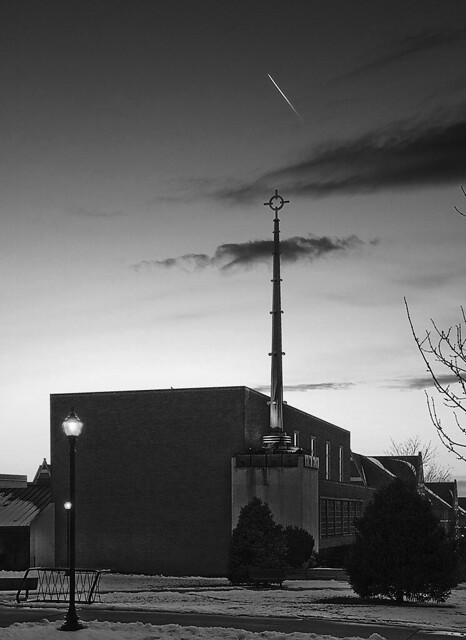
Museum of Contemporary Religious Art, at Saint Louis University. I needed to convert my image, originally in color, to black and white for inclusion in the book Saint Louis University: A Concise History
If you shoot film, and have your own darkroom or film scanner, black and white photography remains rather inexpensive since you are able to develop and print your own quality photos. If you live in a remote area, this may actually be the most convenient solution also. Also, superb quality film cameras are available at low cost. While you can process your own color film, this is rather more expensive and difficult compared to black and white film.
Sometimes, the lighting conditions are so poor that a black and white conversion is the fastest and easiest way to produce a quality images. I will sometimes convert an image taken under sodium vapor lights to black and white, because the color of that lighting is usually unpleasant and detracts from the beauty of the image. I very often do a conversion when I use extremely high ISO or severe curves on an image, both of which produce intense noise.
Nostalgia
Do you pine for a time when style of dress and manners were better? Times that were happier, even if more difficult? Do you feel a twinge of romance when viewing those older things? Then perhaps you like the nostalgic look of black and white photography.
![[Portrait of Doris Day, Aquarium, New York, N.Y., ca. July 1946] (LOC)](http://farm5.static.flickr.com/4123/4931767733_9efbd85d28_z.jpg)
Doris Day, singer and actress, ca. July 1946, New York City. Photograph by William P. Gottlieb.
I must admit to being a bit undecided if this kind of nostalgia is desirable or not: on one hand, this kind of nostalgia is pleasant. But ought we not prepare for the future, where we are inevitably headed? Or rather, ought we live our life in the present, the only time we can truly see? On the other hand, escaping from the drudgery of the present by an imaginative look in the past is sometimes necessary.
We must not fall into the trap of believing the doctrine of inevitable progress, the idea that things are always getting better and better. And likewise, we must not distrust those who prefer older things; for they may not be reactionaries, but rather they might be correct. The theory of evolution implies eternal betterness, but in reality, for every advancement there are multitudes of fatal mistakes. So what we call nostalgia may very well be a rational attraction to things that were in fact better in some way.
Technical advantages
We must be humble enough to realize that older technologies might actually be better in many ways. A large format camera, with quality black and white film, expertly exposed and processed, will have a range of tones and detail that far exceeds any DSLR snapshot. I do use digital photography exclusively, since it is so convenient, but there are trade-offs.
One of the great advantages of black and white photography is the wide contrast range possible. Often in color, it is difficult getting a full range of tones from pure black to white, since your brightest significant detail may be a saturated color — you can't brighten it without losing saturation. This is particularly troublesome if your brightest color is a pure blue -- you just don't have that much room for other tones unless you do severe edits to the image. Blue skies are often a problem: you can't brighten the foreground without risking overexposure of the sky (which will damage the sky color), which is one reason why polarizing filters are so useful.

I inadvertently overexposed the sky on this image, turning it into an implausible shade of cyan: but it looks fine when de-colorized. This is Holy Family log church, in Cahokia, Illinois.
With black and white images, you only have to worry about over- or under-exposing one tone: white or black. With color images, you need to worry about three color channels, any one of which may be poorly exposed, harming the final image. With color, we have a far smaller dynamic range, which is why color images benefit from fairly flat lighting. On the contrary, the masters of black and white photography use the increased dynamic range to excellent effect.

I took this photo for a book on the Gateway Arch. This is a merge of numerous exposures, and the camera was set to automatic white balance. This is a terrible image in several ways, and the yellow sodium vapor lighting is particularly objectionable.
High efficiency electric lighting often has poor color; fluorescent lights are quite bad, due to the unattractive and broad range of green-to-magenta tones found. Sodium vapor lighting, with its narrow yellow-orange color leads to extremely poor color photos. In these cases, a black and white image may be superior.
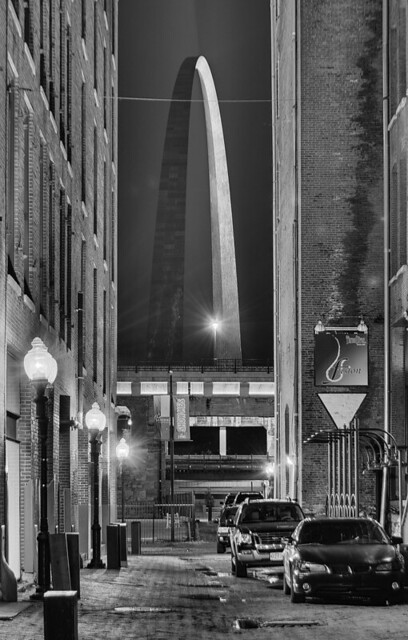
The same series of images, but I converted them to black and white before blending. I did some additional processing on this image, such as applying curves and sharpening. In my opinion, this isn't an image I'd particularly want to see in print, but I do think it is an improvement.
Digital cameras have a linear sensor that respond to light such that twice the brightness registers as twice the signal. Unfortunately, this means that most of the sensor's data is clustered around the very brightest of objects, and there is always a great risk of losing detail through overexposure. This also means that most of the tonal scale will be represented with very little data, which leads to lack of detail and noise in the shadows. So the general advice for digital is that you expose for the highlights and post-process to improve the shadows. Black and white film technology, on the contrary, is known for having great shadow detail — you expose for the shadows and post-process to improve the highlights, and unlike digital, it doesn't have a hard cutoff at the ends of the tonal range. Black and white film is traditionally very good for photography in dim, highly contrasty lighting and is used to good effect in film noir.
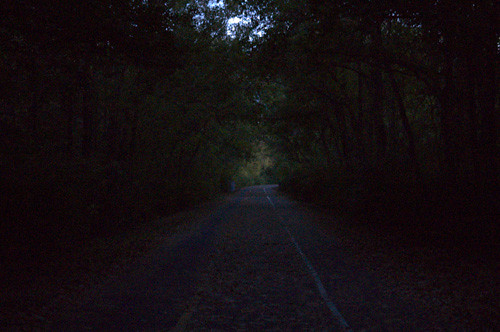
A forest scene, at Gravois Trail, in Saint Louis County, Missouri. This hand-held photo is underexposed, and was shot at ISO 3200. There is hardly any visible detail, and brightening the image would reveal extreme color noise in the shadows.

The same image, converted to black and white — I discarded most of the red and blue channels. I brightened the image greatly, and applied some noise reduction and sharpening.
Digital noise is most evident in the shadows, and color digital noise is usually ugly and highly undesirable. On the contrary, black and white noise is far less objectionable, and can even improve an image, giving an impression of texture and sharpness. This is often an advantage when shooting at very high ISO, or when brightening a severely underexposed image: a terrible color image can often be dramatically improved by converting it to black and white.
For aesthetics or mood
While nostalgia seeks the better things from the past, and black and white photography may evoke that nostalgia, we must always remember that reality in all ages past is high-resolution, wide-gamut, high-dynamic range color. Would a master photographer of a bygone era have used color photography if it were technologically feasible? Was his mastery of the black and white medium merely making the best of an unsatisfactory situation? Undoubtably for many, although this is speculation. We do in fact know that color technology was eventually widely adopted, and also that black and white never went away.
Color is an important factor in beauty. Bright colors are pleasing, and there are many studies and theories of the psychology of color which assigns good, desirable effects to the various colors. However, the color black is nothingness, the color white can be blinding, and gray is dreary: black and white photography necessarily is less cheerful and pleasant than color. Since black and white is more abstract than color, it can also suggest mystery.
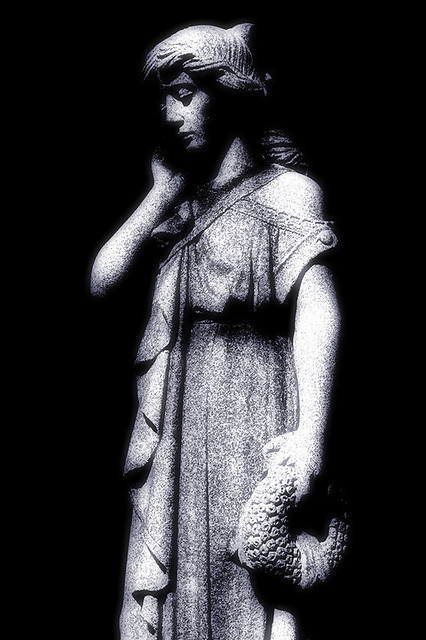
A statue in a cemetery - heavily processed to imply a bleak mood.
So contemporary photographers can use the dreary aesthetics of black and white to evoke a mood of bleakness, despair, and ugliness. This can invoke a kind of anti-nostalgia, seeing not the good in the past, but rather its ugliness, and so black and white photography can be used in a mocking, disparaging fashion. It can also be used with fantasy, where the dull everyday world is seen in black and white, while the fantasy world is in color.
Some conversion hints
When shooting or converting an image to black and white, it is usually essential to adjust the image to give you the full range of tones, otherwise the image may look flat. Good global contrast is essential for a good black and white image. Adjusting curves of color images is a perilous activity: you can have color shifts, oversaturation, and you can send an image out of gamut; these are hardly concerns with black and white images.
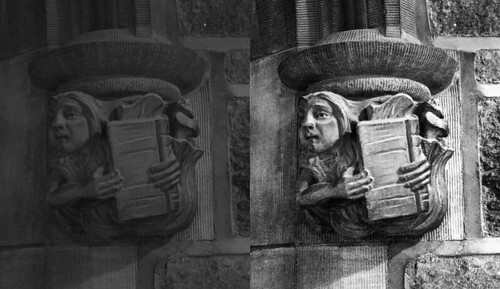
Gothic-style ornament at Washington University in Saint Louis. The straight-forward conversion on the left lacks contrast, which is corrected on the right.
The second important consideration is the conversion of colors to gray tones; there are many ways to do this in Photoshop, and there are some excellent plug-ins that improve the process. Even though you lose color information in your conversion, the various gray tones ought to imply different shades in the final image.

The color image on the left was converted in Photoshop using Image->Mode->Grayscale. This is obviously a fabricated image, since I specifically chose all colors to have the same luminance. Photoshop has many ways to convert to black and white, some may be better than others at implying changes in tone.
Generally speaking, you want to select the parts or combinations of each RGB channels which show good contrast between different objects. If the subject has stripes, you probably will want a conversion that shows the stripes in a good manner -- some conversions may not show the stripes at all. Also, for faces your conversion will have a drastic effect on showing or hiding blemishes and wrinkles. In Photoshop, the Black and White tool is very good for doing this conversion, however, a thorough knowledge of the channel structure of images and the laws of color mixing is very helpful for this.
Finally, you can add far more local contrast to a black and white image compared to color, while still making it look plausible. This final step has been used to great effect by the masters of the medium.